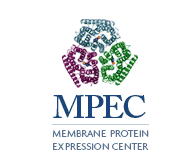Expression Systems Current at MPEC
- Expression in bacteria, using engineered signal sequences selected for improved expression and insertion of heterologous membrane proteins.
- Yeast expression with strains that are engineered to dramatically over-express the endoplasmic reticulum, and at the same time include prevent trafficking from the endoplasmic reticulum to the Golgi. This system packs the expanded endoplasmic reticulum membrane, and prevents further traffic to the Golgi. Thus there is no attachment of polysaccharides for example that lead to heterogeneity.
- Pichia pastoris incorporates the powerful methanol oxidase promoter that can be induced after cells are grown to optimal density.
- Expression in Sf9 insect cells is transient, and relies on infection with a virus, this is important as a standard for expression against which relative success and activity will be measured.
- Expression in HEKs cells transiently infected via the Bacmam system expressed in suspension ES HEK cells rather than attached to plates, where the yield is so much greater.
- Cell free synthesis; In vitro expression is applied and has the advantage that purification is much simpler, and post-translational modifications are purposely not made so as to achieve a homogeneous product. Thus it is applied where non-post-translationally modified proteins are properly structured, and fully functional. This method also has the advantage that it is easy to incorporate altered amino acids, or seleno, or 15N or 13C amino acids into the protein for use in NMR.
